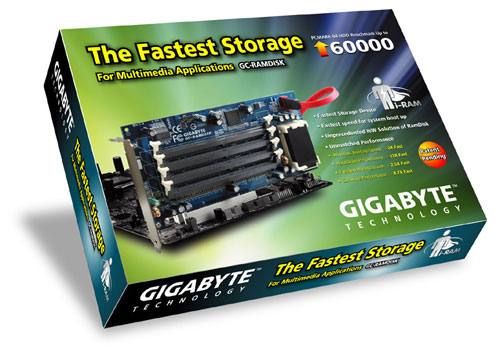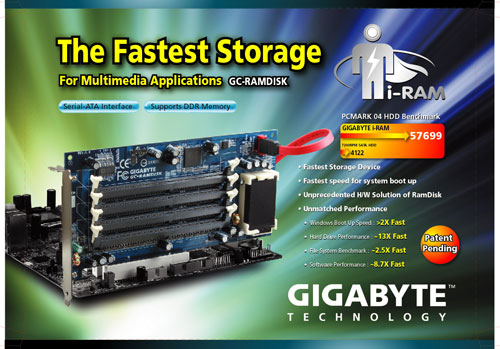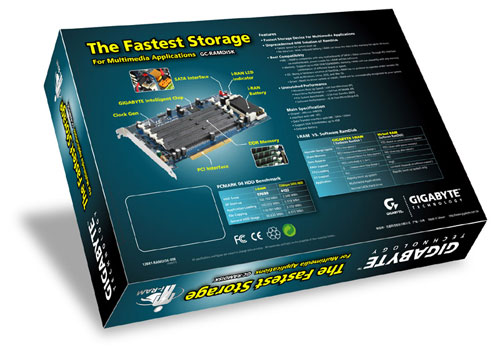Gigabyte's i-RAM: Affordable Solid State Storage
by Anand Lal Shimpi on July 25, 2005 3:50 PM EST- Posted in
- Storage
For years now, motherboard manufacturers have been struggling to find other markets to branch out to, in an attempt to diversify themselves, preparing for inevitable consolidation in the market. Every year at Computex, we'd hear more and more about how the motherboard business was getting tougher and we'd see more and more non-motherboard products from these manufacturers. For the most part, the non-motherboard products weren't anything special. Everyone went into making servers, then multimedia products, then cases, networking, security, water cooling; the list goes on and on.
This year's Computex wasn't very different, except for one thing. When Gigabyte showed us their collection of goodies for the new year, we were actually quite interested in one of them. And after we posted an article about it, we found that quite a few of you were very interested in it too. Gigabyte's i-RAM was an immediate success and it wasn't so much that the product was a success, but it was the idea that piqued everyone's interests.
Pretty much every time a faster CPU is released, we always hear from a group of users who are marveled by the rate at which CPUs get faster, but loathe the sluggish rate that storage evolves. We've been stuck with hard disks for decades now, and although the thought of eventually migrating to solid state storage has always been there, it's always been so very distant. These days, you can easily get a multi-gigabyte solid state drive if you're willing to spend the tens of thousands of dollars it costs to get one; prices actually vary from the low $1000s to the $100K range for solid state devices, obviously making them impractical for desktop users.
The performance benefits of solid state storage have always been tempting. With no moving parts, reliability is improved tremendously, and at the same time, random accesses are no longer limited by slow and difficult to position read/write heads. While sequential transfer rates have improved tremendously over the past 5 years, thanks to ever increasing platter densities among other improvements, it is the incredibly high latency that makes random accesses very expensive from a performance standpoint for conventional hard disks. A huge reduction in random access latency and increase in peak bandwidth are clear performance advantages to solid state storage, but until now, they both came at a very high price.
The other issue with solid state storage is that DRAM is volatile, meaning that as soon as power is removed from the drive, all of your data would be lost. More expensive solutions get around this by using a combination of a battery backup as well as a hard disk that keeps a backup of all data written to the solid state drive, just in case the battery or main power should fail.
Recognizing the allure of solid state storage, especially to performance-conscious enthusiast users, Gigabyte went about creating the first affordable solid state storage device, and they called it i-RAM.
Through some custom logic, the i-RAM works and acts just like a regular SATA hard drive. But how much of a performance increase is there for desktop users? And is the i-RAM worth its still fairly high cost of entry? We've spent the past week trying to find out...
This year's Computex wasn't very different, except for one thing. When Gigabyte showed us their collection of goodies for the new year, we were actually quite interested in one of them. And after we posted an article about it, we found that quite a few of you were very interested in it too. Gigabyte's i-RAM was an immediate success and it wasn't so much that the product was a success, but it was the idea that piqued everyone's interests.
Pretty much every time a faster CPU is released, we always hear from a group of users who are marveled by the rate at which CPUs get faster, but loathe the sluggish rate that storage evolves. We've been stuck with hard disks for decades now, and although the thought of eventually migrating to solid state storage has always been there, it's always been so very distant. These days, you can easily get a multi-gigabyte solid state drive if you're willing to spend the tens of thousands of dollars it costs to get one; prices actually vary from the low $1000s to the $100K range for solid state devices, obviously making them impractical for desktop users.
The performance benefits of solid state storage have always been tempting. With no moving parts, reliability is improved tremendously, and at the same time, random accesses are no longer limited by slow and difficult to position read/write heads. While sequential transfer rates have improved tremendously over the past 5 years, thanks to ever increasing platter densities among other improvements, it is the incredibly high latency that makes random accesses very expensive from a performance standpoint for conventional hard disks. A huge reduction in random access latency and increase in peak bandwidth are clear performance advantages to solid state storage, but until now, they both came at a very high price.
The other issue with solid state storage is that DRAM is volatile, meaning that as soon as power is removed from the drive, all of your data would be lost. More expensive solutions get around this by using a combination of a battery backup as well as a hard disk that keeps a backup of all data written to the solid state drive, just in case the battery or main power should fail.
Recognizing the allure of solid state storage, especially to performance-conscious enthusiast users, Gigabyte went about creating the first affordable solid state storage device, and they called it i-RAM.



Through some custom logic, the i-RAM works and acts just like a regular SATA hard drive. But how much of a performance increase is there for desktop users? And is the i-RAM worth its still fairly high cost of entry? We've spent the past week trying to find out...










133 Comments
View All Comments
RobRedman - Saturday, October 7, 2006 - link
I must have 50 sticks of unused PC100 and PC133 SDRAM.Something like this for old RAM would be a value, (for me).
Does anyone know of an adapter that would take, lets say, 10 sticks of SDRAM and give me an IDE or USB connector?
ITLisa - Saturday, October 1, 2005 - link
I spent a little time looking for this and not even the manufacturer lists it on their sitemtownshend - Tuesday, March 14, 2006 - link
It was on Gigabytes site as I looked today and the past month while making the descion to get it.There's been a lag while retailers get rid of the v.1.2 and Gigabyte sends out the v1.3 cards.
I just got one of the new ones and will use it to run my FTP server application. I have 14 or 16 drives connected (6TB) to the server and previous reviews by others have pointed to the performance increse from the FTP app. searching and retaining the disk locations.
since I just got it I am not %100 on the reality, and the real benifit will be realized by the client seeking a file from the server. Using it for MS SQL Server is also a great idea. Other than that I haven't heard any real world uses, I mean users might be able to load Doom faster, but this device seems to be a bit expensive for most.
Also this card is bigger in area than most video cards, so if your box is crammed w/ wires or liquid pumps and resivours. The logistics of getting say 2 video cards and the RamDisk in a midsized case are pretty obsurd. Plus you need a fan or 2 in there to swirl around the heat generated by 3 heat monger cards) ...There goes more money in a bigger case.
For the general user, I would go with the new Raptor (the clear one) if you want to compromise speed, size and cost on a rational level.
Peace all
lrohrer - Tuesday, September 13, 2005 - link
The simplelist and best use of the i-ram is to store the "Temp DB" for SQL Server. MS SQL Server constanly writes to this database in most larger installations. It is temporary and by definitions does need to exist after reboot. (Alas SQL Server does not/CAN NOT keep this database in RAM) So on reboot a script will need to verify that it is still formatted and the appropriate file system/ files exist -- copied from the hard disk. SQL Serve is fussy about hardware so it masquerading as a disk is perfect.In an hour on google I can't find someone to sell it to my boss to try it out. sigh.
My prediction is a 5-10% boost to overall throughput on a SQL server installation with lots of "temp DB" activilty -- well worth the cost of the ram chips.
brandonbates - Friday, August 5, 2005 - link
I've been keeping an eye on ram disks for a little while now, but other than software they are just too expensive. The earlier post that had links to them (both flash and DRAM based disks) was the same stuff that I found. More recently I had been relieved by the availability of 64bit Systems and OSes with more slots/address space for ram and thus bigger ram disks. But it still really burned me that someoune couldn't make something really cheap that didn't rely on a big fat motherboard (which still has only so many slots, but admittedly faster).This qualifies. The second I heard about this while reading computex stuff I said to myself: Self, this thing only takes power from the PCI bus, therefore it would be a trivial thing to buy some PCI slots (like 8) and wire them for power, then raid or jbod these together and get one heck of database drive at a fraction of the cost of other solutions, and scaleable at that (I can start out with 2 or 3).
I also think it would be a nice (and easy) thing for them to put it in a 3.5" form factor with both molex and/or 3.3v standby loopthrough (through a pci dummy card or something). And yes 8 slots would be much more saleable, understanding that the mem controller may not support that (though some sort of bank switch would work since you have time to wait for the SATA or SATA2 bus, 3.5 form factor would get difficult with 8 slots though).
The situation that got me looking at this stuff is I have a mysql database (tested others as well) that has to do a table scan each time I do a query since it is a '%something%' query (loading web logs and running user demanded reports on them) The database is at around 4 gigs already (about 6 months worth, including 0.5GB packed indexes) and the report takes about two minutes (2 15k drives in RAID 1, not bad) But I still have to run it at night and make a summary table. (maybe a database with multithreaded partitions or grid would do it, but how much does that cost???!?) Anyway, my 2 cents (sorry for the long post). I'd really, really like to know what benchmarks say the latency for this thing is.
Zar0n - Tuesday, August 2, 2005 - link
For a mass product gigabyte needs to add.8 dimm slots
SATA2
Let's hope they do it fast...
ybbor - Friday, July 29, 2005 - link
What would happen if you stored a SQL database on the drive... wonder what it would do for database proformance benchmarks.you would probably back up to HD every night, or cluster with db on HD for data integrety
Chadder007 - Friday, July 29, 2005 - link
They should have went with a SATA II capable interface instead of regular SATA since it has much more capable bandwidth sitting there waiting to be used. Also the 4 gig of mem only hurts it a tad too.optiguy - Friday, July 29, 2005 - link
Now just as a thought to scary uses for the i-RAM. Law enforcement will hate these things. Peadophiles will have instant access to wiping there files without a trace, terrorist won't have to worry about the good guys being able to track their files.mindless1 - Friday, July 29, 2005 - link
Nope, pedos have a compulsive urge to collect stuff, 4GB wouldn't even come close. Besides, if the pedo was thinking that far in advance, there are plenty of already-existent technologies far more secure. When the cops come busting down someone's door, do you think they'll saw something like "freeze, don't move, unless you prefer to go over to your computer and wipe data!" ? Then again, general ignorance about the need to keep the evidence battery charged could be an issue.